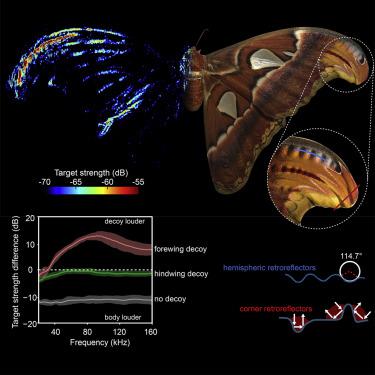Current Biology ( IF 8.1 ) Pub Date : 2021-09-09 , DOI: 10.1016/j.cub.2021.08.038 Thomas R Neil 1 , Ella E Kennedy 1 , Brogan J Harris 1 , Marc W Holderied 1

|
Sensory coevolution has equipped certain moth species with passive acoustic defenses to counter predation by echolocating bats.1,2 Some large silkmoths (Saturniidae) possess curved and twisted biosonar decoys at the tip of elongated hindwing tails.3,4 These are thought to create strong echoes that deflect biosonar-guided bat attacks away from the moth’s body to less essential parts of their anatomy. We found that closely related silkmoths lacking such hindwing decoys instead often possess intriguing ripples and folds on the conspicuously lobed tips of their forewings. The striking analogy of twisted shapes displayed far from the body suggests these forewing structures might function as alternative acoustic decoys. Here we reveal that acoustic reflectivity and hence detectability of such wingtips is higher than that of the body at ultrasonic frequencies used by hunting bats. Wingtip reflectivity is higher the more elaborate the structure and the further from the body. Importantly, wingtip reflectivity is often considerably higher than in a well-studied functional hindwing decoy. Such increased reflectivity would misdirect the bat’s sonar-guided attack toward the wingtip, resulting in similar fitness benefits to hindwing acoustic decoys. Structurally, folded wingtips present echo-generating surfaces to many directions, and folds and ripples can act as retroreflectors that together create conspicuous targets. Phylogenetically, folds and ripples at wingtips have evolved multiple times independently within silkmoths and always as alternatives to hindwing decoys. We conclude that they function as acoustic wingtip decoys against bat biosonar.
Video abstract
Download : Download video (33MB)
中文翻译:

土星飞蛾的翼尖褶皱和涟漪对蝙蝠生物声纳产生诱饵回声
感觉共同进化为某些飞蛾物种配备了被动声学防御,以对抗回声定位蝙蝠的捕食。1 , 2一些大型蚕蛾 (Saturniidae) 在细长的后翅尾部末端具有弯曲和扭曲的生物声纳诱饵。3 , 4这些被认为会产生强烈的回声,将生物声纳引导的蝙蝠攻击从飞蛾的身体转移到其解剖结构中不太重要的部分。我们发现,缺乏这种后翅诱饵的密切相关的蚕蛾往往在其前翅明显裂开的尖端上具有迷人的波纹和褶皱。远离身体的扭曲形状的惊人类比表明,这些前翅结构可能起到替代声学诱饵的作用。在这里,我们揭示了这种翼尖的声反射率和因此的可检测性高于狩猎蝙蝠使用的超声波频率下的身体。翼尖反射率越高,结构越精细,离机身越远。重要的是,翼尖反射率通常比经过充分研究的功能性后翼诱饵高得多。这种增加的反射率会将蝙蝠的声纳引导攻击误导到翼尖,从而产生与后翼声学诱饵类似的适应性益处。在结构上,折叠的翼尖向多个方向呈现回波产生表面,并且折叠和波纹可以作为回射器共同形成显眼的目标。在系统发育上,翼尖处的褶皱和波纹在蚕蛾内独立进化了多次,并且始终作为后翅诱饵的替代品。我们得出结论,它们作为声学翼尖诱饵对蝙蝠生物声纳起作用。褶皱和波纹可以作为逆向反射器,共同创造出显眼的目标。在系统发育上,翼尖处的褶皱和波纹在蚕蛾内独立进化了多次,并且始终作为后翅诱饵的替代品。我们得出结论,它们作为声学翼尖诱饵对蝙蝠生物声纳起作用。褶皱和波纹可以作为逆向反射器,共同创造出显眼的目标。在系统发育上,翼尖处的褶皱和波纹在蚕蛾内独立进化了多次,并且始终作为后翅诱饵的替代品。我们得出结论,它们作为声学翼尖诱饵对蝙蝠生物声纳起作用。
视频摘要
下载:下载视频 (33MB)











































 京公网安备 11010802027423号
京公网安备 11010802027423号